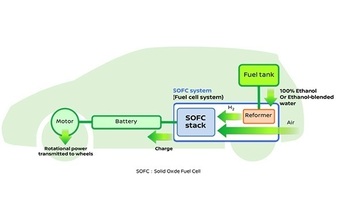
Fuel-cell systems use chemicals that react with oxygen, generating power without release of harmful byproducts. Bio-ethanol fuels, including those sourced from sugarcane and corn, are widely available in countries in North and South America, and Asia. The e-Bio Fuel-Cell, using bio-ethanol, can offer eco-friendly transportation and create opportunities in regional energy production, while supporting existing infrastructure.
When power is generated in a fuel-cell system, CO2 is usually emitted., With the bio-ethanol system, CO2 emissions are neutralized from the growing process of sugarcane making up the bio-fuel, allowing it to have a "Carbon-Neutral Cycle," with nearly no CO2 increase whatsoever.
The Future of e-Bio Fuel-Cell: In the future, the e-Bio Fuel-Cell will become even more user-friendly. Ethanol-blended water is easier and safer to handle than most other fuels. As this will remove limits on creating a totally new infrastructure, it has great potential for market growth.
Running costs will be remarkably low—on par with today's EVs, ultimately benefitting the public as well as businesses, because the e-Bio Fuel-Cell is an ideal fit for wider customer needs because of the short refueling time and ample power supply that can support a range of services such as refrigerated delivery.
(Continued on the next page)



























